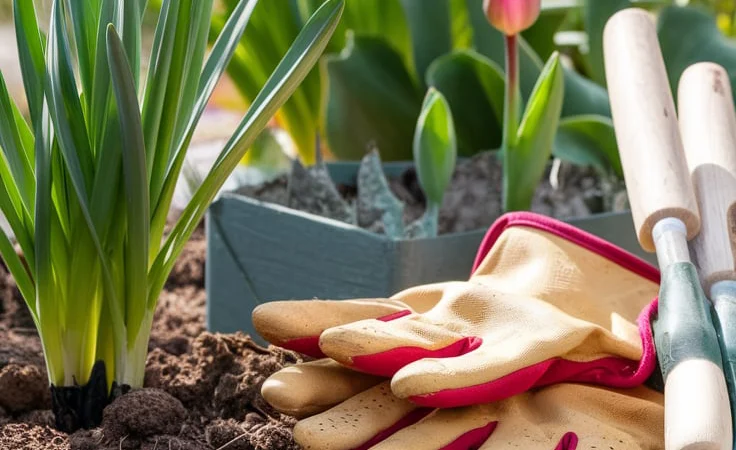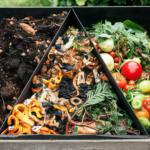I don’t know about you, but every spring, I swear I’m on top of it. I’m going to prep early, get all my plants in on time, and finally stop waiting until my garden gloves have holes the size of actual potholes before replacing them. And every spring, I somehow end up standing in my yard, staring at a half-dug garden bed, realizing I forgot something important. Again.
Every year, I tell myself, “This is the year I’m organized!” And every year, I proceed to run around like a lost chicken, frantically trying to remember if I bought compost or if I just thought about buying compost.
So, after way too many seasons of winging it and acting surprised when plants require actual planning, I finally made a real checklist. One I could actually stick to. One that stops me from getting distracted by impulse-buying yet another pack of seeds I’ll never remember to plant. It has saved me from my own bad habits more times than I care to admit.
Now, instead of running around in a panic, I actually know what I’m doing. Well, mostly. At least now my forgetfulness is contained to smaller things, like misplacing my trowel immediately after putting it down.
Spring is the best time of year to get outside and dig in the dirt. Everything is coming back to life, the sun doesn’t feel like it’s out to destroy us yet, and there’s a real sense of possibility in the air. But let’s be honest—it can also be chaos. There’s so much to do, and the second you think you’re ahead, some random plant reminds you that it needed to be started a month ago.
That’s why this checklist exists. If you’ve been gardening for years, this will keep you on track. If you’re just getting started, it’ll save you from at least a few of the classic “oh no” moments.
Let’s get to it. This year, we’re actually going to stay on top of it. Or at least fake it really well.
Step 1: Clean Up Your Garden
Winter did what winter does best—left behind a mess. Leaves everywhere, twigs in places twigs shouldn’t be, and weeds that somehow survived the cold like they were training for a survival show. Before anything new can grow, it’s time for a clean slate.
- Toss the dead stuff – Leaves, branches, and anything that looks like it gave up months ago. Out.
- Weed before they take over your life – They seem small now, but trust me, they’ve got plans. Pull them while you still have the upper hand.
- Prune like a pro – Trim back anything that’s dead or looking a little too wild for its own good.
- Rake through garden beds – Leftover plant debris? Say goodbye. Fresh soil? Say hello.
Picture this: A freshly raked garden bed, dark soil turned over and prepped for new plants. A pair of gloves tossed casually on the side, a rake leaning against the fence, and the sun casting that perfect springtime glow.
Step 2: Prep Your Soil
Great soil means great plants. Ignore it, and you might as well be planting your tomatoes in an abandoned sandbox.
- Test it before guessing – A quick test will tell you if your soil is thriving or if it needs a little boost. It’s like checking your phone battery before heading out.
- Feed it like it’s been through a long winter – Compost, organic matter, anything to get those nutrients back in play.
- Loosen things up – If your soil is packed tighter than your schedule, grab a fork (the gardening kind) and aerate it. Roots need space to stretch.
- Mulch for the win – Keeps moisture in, keeps weeds out, makes the garden look like you really know what you’re doing.
Picture this: Hands dusted with soil, spreading rich, dark compost over a flower bed. Tiny green shoots starting to peek through. Sunlight breaking through tree branches, making the whole thing feel like a scene from a gardening magazine.
Step 3: Plan Your Planting
This is the fun part. The moment where you get to imagine all the things you’ll grow, even though you might only have space for half of them.
- Pick plants that won’t betray you – Cool-weather veggies like lettuce, spinach, and peas actually want to grow in early spring. Hardy flowers like pansies and snapdragons? Also in.
- Start seeds inside like an overprotective plant parent – Some things need a head start. Give them a cozy windowsill and watch them go.
- Companion plant like a matchmaker – Some plants thrive together, others… not so much. A little research goes a long way.
- Make a plan before you impulse plant – It’s tempting to just wing it, but mapping out what goes where will save you from future regret.
Picture this: A potting table covered in seed packets, an open gardening book flipped to a page with scribbled notes, and a windowsill lined with tiny pots waiting for their moment to shine.
Step 4: Check Your Tools
Nothing kills the gardening mood faster than grabbing a rusty trowel or realizing your pruners are basically butter knives at this point.
- Inspect everything – If it’s broken, cracked, or looks like it’s been through a battle, deal with it now.
- Sharpen blades unless you want to hack at things like a caveman – Clean cuts help plants heal. Dull blades just… don’t.
- Oil up the moving parts – A little maintenance now saves you from wrestling with rusty tools later.
- Restock before the season sneaks up on you – Missing gloves? Trowel vanished into the gardening void? Fix that before planting day.
Picture this: A sturdy workbench with a fresh pair of gloves, a lineup of clean, sharpened tools, and a slightly smug gardener ready to actually be prepared this year.y oiled pair of garden shears. Bright green gardening gloves hang neatly on a hook, ready to dig into the season’s tasks.
Step 5: Tackle Hardscaping
Spring is the perfect time to spruce up the non-plant elements of your garden and make your space more functional and beautiful.
- Repair fences and trellises: Check for damage caused by winter storms and fix loose boards, broken posts, or leaning trellises.
- Clean patios and paths: Power wash stone or concrete surfaces to remove grime and bring back their natural shine.
- Add garden features: Consider installing a new birdbath, trellis, or decorative statues to enhance your outdoor space.
- Organize your shed: Create a functional storage system with hooks, bins, and shelves to keep tools, pots, and supplies tidy.
Step 6: Water Wisely
Hydration is key for a thriving garden, and setting up an efficient watering system now will save time and effort all season long.
- Inspect irrigation systems: Check hoses, sprinklers, and drip lines for leaks, clogs, or damage and make necessary repairs.
- Adjust watering schedules: Water early in the morning to reduce evaporation and give plants a fresh start to the day.
- Set up rain barrels: Install rain barrels under downspouts to collect water for an eco-friendly way to keep your garden hydrated.
Step 7: Welcome Wildlife
Your garden isn’t just for you—it’s a haven for pollinators, birds, and beneficial insects. Inviting them in helps your plants thrive while adding life and movement to your space.
- Plant pollinator-friendly flowers: Choose blooms like lavender, sunflowers, and marigolds to attract bees, butterflies, and other pollinators.
- Set up a bird feeder: Provide seeds, fresh water, or suet to encourage birds to visit your garden.
- Build a bug hotel: Use natural materials like wood, bamboo, and pinecones to create a cozy space for helpful insects like ladybugs, bees, and lacewings.
Picture This: A vibrant garden filled with colorful flowers like marigolds and sunflowers, buzzing with happy bees and fluttering butterflies. In one corner, a handmade bug hotel made of bamboo and twigs rests against a fence, while a charming bird feeder hangs nearby, with birds chirping cheerfully as they enjoy their feast.
Spring is here, and I can’t wait to see how your garden grows this season! Whether you’re cleaning up winter’s leftovers, planning your dream planting calendar, or welcoming pollinators into your space, this checklist has everything you need to create your most thriving, beautiful garden yet. The best part? You don’t have to tackle it all at once—take it step by step, enjoy the process, and soak in those moments where it all comes together.
Gardening isn’t just about the plants; it’s about creating something magical, one seed, one flower, one fresh idea at a time. It’s those quiet early mornings watering your garden, the first bloom that surprises you, and the satisfaction of watching everything thrive under your care. Each step on this list is a way to nurture not just your garden, but your connection to the earth and the joy of growing something beautiful.
Are you starting your spring garden? I’d love to see what you’re working on! Share your progress in the comments or tag me on Instagram with #LifeAndSubscribe—I can’t wait to cheer you on and maybe get a little inspiration from you, too! And don’t forget to save this checklist for your next gardening session. Pin it, bookmark it, or print it out—whatever helps make your gardening life easier.
Here’s to a season filled with fresh blooms, lush greenery, and a garden you’ll be proud of. Happy gardening, my friend! 🌸🌱✨
FAQ
What is the gardening 3-year rule?
The 3-year rule in gardening usually refers to crop rotation, which helps keep soil healthy and plants thriving. The idea is simple:
- Year 1: Plant heavy feeders (e.g., tomatoes, corn, cabbage) that use up a lot of nutrients.
- Year 2: Follow with light feeders (e.g., carrots, onions, herbs) that don’t deplete the soil as much.
- Year 3: Grow soil builders (e.g., beans, peas, clover) that return nutrients, especially nitrogen, back into the soil.
Then, you repeat the cycle. This prevents soil exhaustion, reduces pests and disease, and makes your garden way easier to maintain.
When should I start preparing my garden for spring?
The best time to start prepping depends on your climate, but late winter to early spring is the sweet spot.
- 6–8 weeks before the last frost: Start seeds indoors for plants that need a head start.
- 4–6 weeks before the last frost: Clean up garden beds, prune shrubs, and test your soil.
- 2–4 weeks before planting: Add compost, aerate compacted soil, and lay down mulch.
- Right before planting: Check tools, make a planting plan, and get seedlings ready to go outside.
If you live somewhere with mild winters, you might even be able to start earlier. But for most gardeners, late February to March is when the real action begins.
What is the best thing to plant in spring?
Spring is prime time for planting cool-season vegetables and hardy flowers. Here’s what thrives:
- Early Spring (Before Last Frost)
- Leafy greens (lettuce, spinach, kale)
- Root veggies (carrots, radishes, beets)
- Peas
- Herbs (parsley, chives, cilantro)
- Mid-Spring (After Last Frost)
- Tomatoes
- Peppers
- Cucumbers
- Zucchini
- Beans
- Flowers to brighten things up
- Pansies
- Snapdragons
- Daffodils and tulips (if planted in fall)
If you time it right, you’ll have fresh produce early in the season and a colorful garden to enjoy.
What is a gardener’s daily routine?
A gardener’s day depends on the season, but in spring and summer, the routine often looks like this:
Morning:
- Check the weather (plants like a forecast too)
- Water plants early to avoid evaporation
- Harvest anything that’s ready
Afternoon:
- Weed before they take over
- Prune dead or overgrown branches
- Stake or trellis any plants that need support
Evening:
- Inspect for pests and diseases
- Plan tomorrow’s tasks
- Give everything a final look—because let’s be honest, there’s always one more thing to do
It’s a mix of maintenance, observation, and a little bit of winging it. But that’s what makes it fun.






